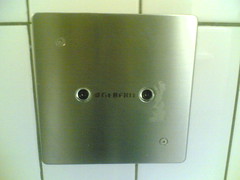Coexistence of Systems and System Failures
Posted: January 18th, 2007 | 1 Comment »Jan Chipchase has post on a remote control to operate the toilet with peace-of-mind-security coverage placed next to the toilet interface. So when house guests are wanting to flush and aren’t familiar with these interfaces it is no surpise that the ‘wrong’ button is pressed and an alarm sounds, and the security company sends out a uniformed emergency response team. There is of course many wrong approaches in this future-perfect-connected world situation. Yet, it reminded me of the thoughts of Adam Greenfield on the the blue toilet of death highlighting the coexistence of systems surrounding us and their nonlinear interactions and the affective dimensions of system failure (advocating for “graceful degradation”).
And still nobody was talking about the nonlinear interactions of network systems in one space all operating at once – it’s as if none of the people who were designing them had, not so much thought, but felt what it would be like to sit in the middle of a room where you’ve got fifteen different technical interfaces around you, and you’re responding to all of them at once, and they’re all responding to you at once.
[...]
But I’m not sure how many people in academic ubicomp have really marinated themselves in a consideration of the experiential and affective dimensions of system failure. I’m not sure to what degree people have ever simply sat and imagined what it will feel like when systems like these surround us…and break down, as technical systems often do. They may have thought about the specific system at hand, but as a gestalt? I haven’t heard that many people raising the issue.
These kind of problems are exemplified by Fabio Sergio and his story with motion sensors in a bathroom and considerations on reactive system as well as by Mark Meagher on automatic doors and how the funtionality of the door are invisible and no attempts are made to communicate to the user.
I enjoy observing people (and myself) waving my hands in front of a tap or to an automatic doors. Doors in swiss train are particularly prone to the situations described by Mark. Their opening is often slow, maybe due to the overuse of the sensors or most probably to their bad calibration. Some train have sensor on the floor (opening when you step in). It is not unusual to see people jumping or hardly stepping in front of the doors. Other trains have their sensors in the top and bottom of the door. I noticed that even some train directors do it and some people refusing the automation and manually forcing the door to open. I am wondering if there is ever been a study a user-centered study to calibrate the swiss train automatic doors to lower the user confusion.

Geberit’s eyes, motion sensor in a bathroom
Relation to my thesis: My work highlights to problem of integrating technological limitations (such as system not being able to coexists) and human factors in real-world environments. I already mentioned it in Peaceful Cohabitation and Scalability in Ubicomp. I am exploring how to support user activities top of errors and system-generated uncertainty. In the context of interaction, I guess it is not only important for interfaces to reveal their functionalities and states, but also to think in terms of granularity (for example to calibrate thee automatic doors) as express by Mike Kuniavsky.


[...] that topic, see also Fabien’s experience as well as Fabio Sergio’s story. Clive Grinyer has good thoughts about it [...]